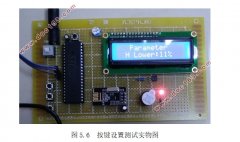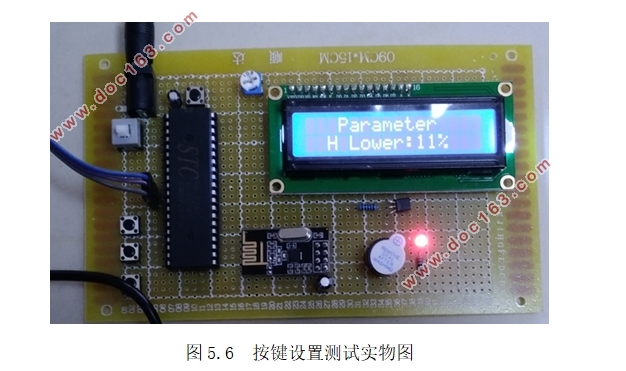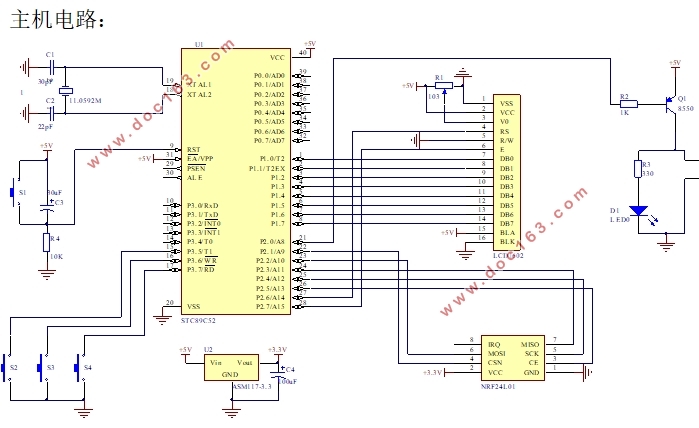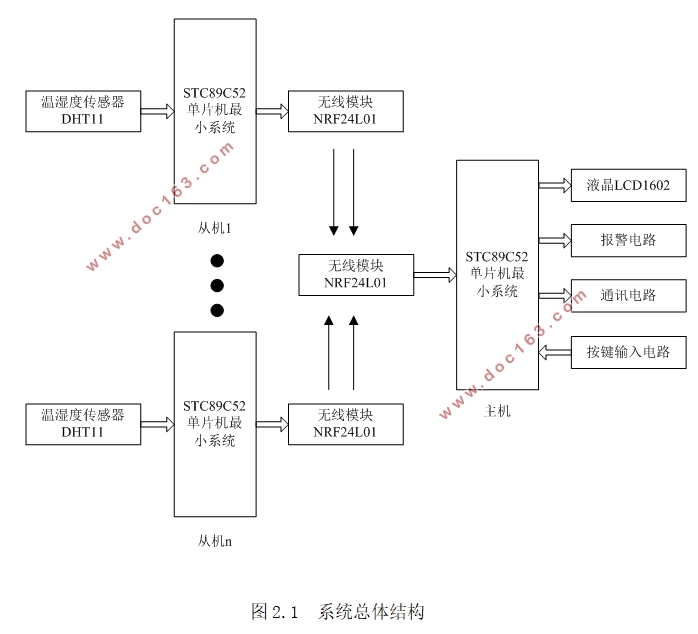粮库温湿度无线监测系统设计

1.无需注册登录,支付后按照提示操作即可获取该资料.
2.资料以网页介绍的为准,下载后不会有水印.资料仅供学习参考之用.
密 惠 保
粮库温湿度无线监测系统设计(任务书,开题报告,论文11200字)
摘 要
本文通过STC89C52单片机及无线通讯技术,设计了粮库温湿度无线监测装置,对粮库粮食的存储环境检测与控制具有一定的意义。
论文主要研究了粮库温湿度测量系统的从机和主机,从机采用温湿度传感器DHT11测量粮库温湿度,并通过NRF24L01将从机编码和温湿度数据发送至主机;主机将接收的温湿度数据显示在液晶LCD1602上,并根据设置的温湿度上下限进行声光报警器,温湿度上下限可通过按键进行任意修改;系统还可通过USB转串口将数据发送至计算机上。
研究结果表明:设计的系统可实现温湿度数据的无线传输和存储,并可实现报警、液晶显示、温湿度范围设置等功能。
本文的特色:采用无线通讯实现温湿度数据的传输,且主机可将数据传送至计算机上存储。
关键词:粮库温湿度;无线通讯;单片机;LCD1602
Abstract
In this paper, the wireless monitoring device of temperature and humidity in grain depot is designed by STC89C52 single chip microcomputer and wireless communication technology, which is of certain significance for the storage environment detection and control of grain depot.
This paper mainly studies the engine and host of the temperature and humidity measurement system of the grain depot. The temperature and humidity of the grain depot is measured by the temperature and humidity sensor DHT11, and the data from the machine code and the temperature and humidity are sent to the host by NRF24L01. The temperature and humidity data received by the host are displayed on the liquid crystal LCD1602, and the temperature and humidity limits set are carried out. The acousto-optic alarm, the upper and lower limits of temperature and humidity can be modified by buttons, and the system can send data to the computer through USB serial port.
The research results show that the designed system can realize wireless transmission and storage of temperature and humidity data, and can realize the functions of alarm, LCD display, temperature and humidity range setting and so on.
The characteristic of this article is to use wireless communication to realize the transmission of temperature and humidity data, and the host can transfer data to the computer for storage.
[来源:http://www.think58.com]
Key Words:Grain storehouse temperature and humidity; wireless communication; single chip microcomputer; LCD1602
[版权所有:http://think58.com]



目 录
第1章 绪论 1
1.1 研究背景及意义 1
1.2 国内外研究现状 1
1.3 研究内容及论文结构设置 2
1.4 本章小结 2
第2章 系统总体方案设计 3
2.1 主要器件方案论证 3
2.1.1 控制核心选择 3
2.1.2 温湿度传感器选择 3
2.1.3 无线模块选择 3
2.1.4 显示器选择 4
2.1.5 按键输入模块选择 4
2.1.6 电源模块选择 4
2.2 系统总体方案 4
2.3 本章小结 5
第3章 系统硬件电路设计 6
3.1 单片机最小系统电路设计 6
3.1.1 STC89C52简介 6
3.1.2 单片机最小系统电路 7
3.2 温湿度采集电路设计 8
3.2.1 DHT11简介 8
3.2.2 湿度采集电路 9
3.3 通讯模块电路设计 9
3.3.1 NRF24L01简介 9
3.3.2 SPI接口介绍 10
3.3.3 NRF2401模块电路 11
3.4 液晶显示电路设计 11
3.4.1 LCD1602简介 11
3.4.2 液晶显示电路 12
3.5 报警电路设计 13
3.6 按键电路设计 14
3.7 稳压电路设计 14
3.8 本章小结 14
第4章 系统软件设计 15
4.1 C语言及编译软件简介 15
4.2 系统主程序设计 15
4.3 温湿度读取程序设计 16
4.4 无线通讯程序设计 17
4.5 液晶显示程序设计 18
4.6 报警程序设计 19
4.7 按键扫描程序设计 20
4.8 本章小结 21
第5章 系统调试 22
5.1 系统测试 22
5.2 本章小结 24
第6章 总结 25
参考文献 26
致 谢 28
附 录 29 [资料来源:http://THINK58.com]
